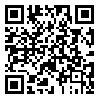Volume 12, Issue 1 (5-2018)
payavard 2018, 12(1): 25-33 |
Back to browse issues page
Download citation:
BibTeX | RIS | EndNote | Medlars | ProCite | Reference Manager | RefWorks
Send citation to:



BibTeX | RIS | EndNote | Medlars | ProCite | Reference Manager | RefWorks
Send citation to:
Nobakht S, Bagheri S, Mehraeen E, Shamsabadi A R. The Feasibility of Telemedicine Technology Implementation in the Selected Hospitals of Iran. payavard 2018; 12 (1) :25-33
URL: http://payavard.tums.ac.ir/article-1-6470-en.html
URL: http://payavard.tums.ac.ir/article-1-6470-en.html
1- Master of Sciences Student in Health Care Management, School of Medical Sciences, Islamic Azad University, Sciences & Research Branch, Tehran, Iran
2- Master of Science in Biostatistics, Public Health Department, School of Health, Zabol University of Medical Sciences, Zabol, Iran
3- Ph.D. Candidate in Health Information Management, Health Information Management Department, School of Allied Medical Sciences, Tehran University of Medical Sciences, Tehran, Iran ,es.mehraeen@gmail.com
4- Ph.D. Candidate in Health Information Management, Health Information Management Department, School of Allied Medical Sciences, Tehran University of Medical Sciences, Tehran, Iran
2- Master of Science in Biostatistics, Public Health Department, School of Health, Zabol University of Medical Sciences, Zabol, Iran
3- Ph.D. Candidate in Health Information Management, Health Information Management Department, School of Allied Medical Sciences, Tehran University of Medical Sciences, Tehran, Iran ,
4- Ph.D. Candidate in Health Information Management, Health Information Management Department, School of Allied Medical Sciences, Tehran University of Medical Sciences, Tehran, Iran
Abstract: (4272 Views)
Background and Aim: Successful implementation and optimum use of telemedicine technology depends on providing the necessary infrastructure and the success factors of this technology, such as high-speed broadband. The present study is aimed at feasibility study on the implementation of telemedicine in selected hospitals of Iran.
Materials and Methods: This descriptive-analytic study was conducted in selected hospitals in 2016. The data gathering tool was a researcher-made questionnaire that its content validity and structure were measured by four professors of health information management. Reliability of the questionnaire was determined using internal correlation test (Cronbach's alpha=0.83). The results were analyzed using descriptive statistics (average and standard deviation) and inferential statistics.
Results: According to the findings, 82.2% of the hospitals had no access to
high-speed broadband and only 5.5% had optics fiber. Insurance and repayment obstacles and shortages of technical staff were identified as the main barriers and medical personnel's resistance and licensing issues were identified as the low importance barriers to the implementation of this technology. Organizational and cultural factors (p-value=0.001), technical infrastructure (p-value=0.005) and financial requirements (p-value=0.021) of telemedicine technology had a significant difference of 5% error rate with education level and orientation.
Conclusion: Due to barriers such as lack of video conferencing tools, the lack of high-speed broadband, and inadequate funding for the purchase and implementation of the necessary equipment, the studied hospitals currently were not able to provide telemedicine services.
Materials and Methods: This descriptive-analytic study was conducted in selected hospitals in 2016. The data gathering tool was a researcher-made questionnaire that its content validity and structure were measured by four professors of health information management. Reliability of the questionnaire was determined using internal correlation test (Cronbach's alpha=0.83). The results were analyzed using descriptive statistics (average and standard deviation) and inferential statistics.
Results: According to the findings, 82.2% of the hospitals had no access to
high-speed broadband and only 5.5% had optics fiber. Insurance and repayment obstacles and shortages of technical staff were identified as the main barriers and medical personnel's resistance and licensing issues were identified as the low importance barriers to the implementation of this technology. Organizational and cultural factors (p-value=0.001), technical infrastructure (p-value=0.005) and financial requirements (p-value=0.021) of telemedicine technology had a significant difference of 5% error rate with education level and orientation.
Conclusion: Due to barriers such as lack of video conferencing tools, the lack of high-speed broadband, and inadequate funding for the purchase and implementation of the necessary equipment, the studied hospitals currently were not able to provide telemedicine services.
Send email to the article author
| Rights and permissions | |
 |
This work is licensed under a Creative Commons Attribution-NonCommercial 4.0 International License. |





